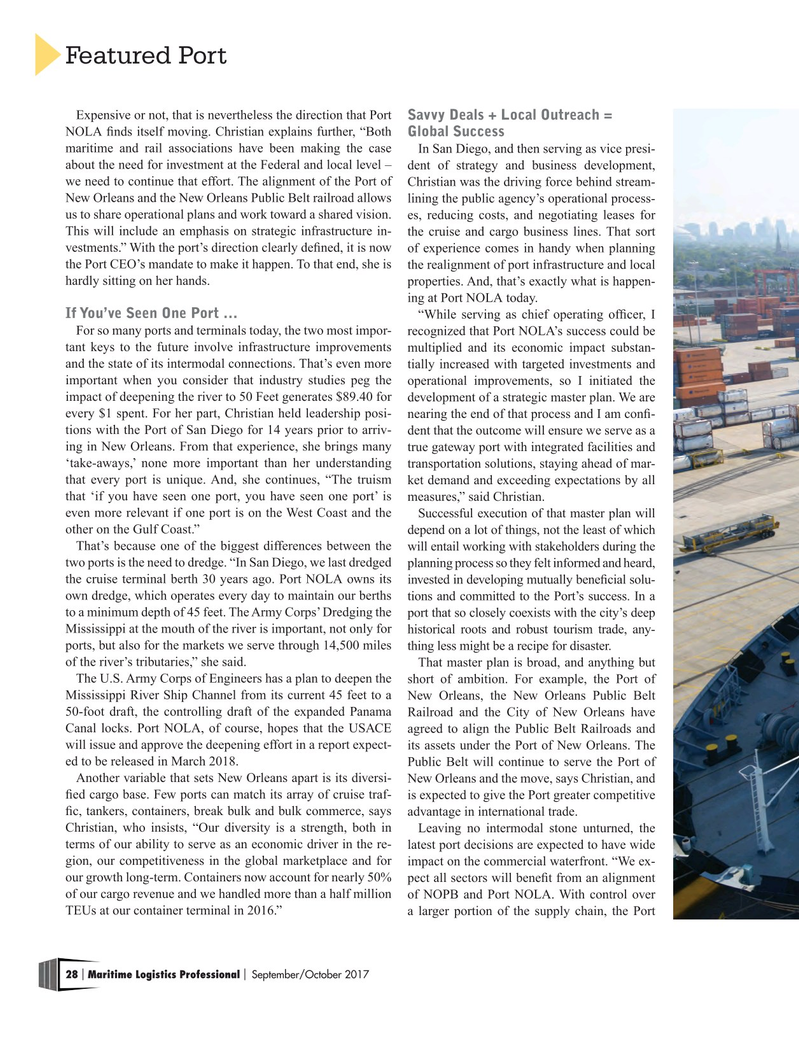
Page 28: of Maritime Logistics Professional Magazine (Sep/Oct 2017)
CONTAINER PORTS
Read this page in Pdf, Flash or Html5 edition of Sep/Oct 2017 Maritime Logistics Professional Magazine
Featured Port
Expensive or not, that is nevertheless the direction that Port
Savvy Deals + Local Outreach =
NOLA fnds itself moving. Christian explains further, “Both
Global Success maritime and rail associations have been making the case In San Diego, and then serving as vice presi- about the need for investment at the Federal and local level – dent of strategy and business development, we need to continue that effort. The alignment of the Port of Christian was the driving force behind stream-
New Orleans and the New Orleans Public Belt railroad allows lining the public agency’s operational process- us to share operational plans and work toward a shared vision. es, reducing costs, and negotiating leases for
This will include an emphasis on strategic infrastructure in- the cruise and cargo business lines. That sort vestments.” With the port’s direction clearly defned, it is now of experience comes in handy when planning the Port CEO’s mandate to make it happen. To that end, she is the realignment of port infrastructure and local hardly sitting on her hands. properties. And, that’s exactly what is happen- ing at Port NOLA today.
If You’ve Seen One Port … “While serving as chief operating offcer, I
For so many ports and terminals today, the two most impor- recognized that Port NOLA’s success could be tant keys to the future involve infrastructure improvements multiplied and its economic impact substan- and the state of its intermodal connections. That’s even more tially increased with targeted investments and important when you consider that industry studies peg the operational improvements, so I initiated the impact of deepening the river to 50 Feet generates $89.40 for development of a strategic master plan. We are every $1 spent. For her part, Christian held leadership posi- nearing the end of that process and I am conf- tions with the Port of San Diego for 14 years prior to arriv- dent that the outcome will ensure we serve as a ing in New Orleans. From that experience, she brings many true gateway port with integrated facilities and ‘take-aways,’ none more important than her understanding transportation solutions, staying ahead of mar- that every port is unique. And, she continues, “The truism ket demand and exceeding expectations by all that ‘if you have seen one port, you have seen one port’ is measures,” said Christian.
even more relevant if one port is on the West Coast and the Successful execution of that master plan will other on the Gulf Coast.” depend on a lot of things, not the least of which
That’s because one of the biggest differences between the will entail working with stakeholders during the two ports is the need to dredge. “In San Diego, we last dredged planning process so they felt informed and heard, the cruise terminal berth 30 years ago. Port NOLA owns its invested in developing mutually benefcial solu- own dredge, which operates every day to maintain our berths tions and committed to the Port’s success. In a to a minimum depth of 45 feet. The Army Corps’ Dredging the port that so closely coexists with the city’s deep
Mississippi at the mouth of the river is important, not only for historical roots and robust tourism trade, any- ports, but also for the markets we serve through 14,500 miles thing less might be a recipe for disaster. of the river’s tributaries,” she said. That master plan is broad, and anything but
The U.S. Army Corps of Engineers has a plan to deepen the short of ambition. For example, the Port of
Mississippi River Ship Channel from its current 45 feet to a New Orleans, the New Orleans Public Belt 50-foot draft, the controlling draft of the expanded Panama Railroad and the City of New Orleans have
Canal locks. Port NOLA, of course, hopes that the USACE agreed to align the Public Belt Railroads and will issue and approve the deepening effort in a report expect- its assets under the Port of New Orleans. The ed to be released in March 2018. Public Belt will continue to serve the Port of
Another variable that sets New Orleans apart is its diversi- New Orleans and the move, says Christian, and fed cargo base. Few ports can match its array of cruise traf- is expected to give the Port greater competitive fc, tankers, containers, break bulk and bulk commerce, says advantage in international trade.
Christian, who insists, “Our diversity is a strength, both in Leaving no intermodal stone unturned, the terms of our ability to serve as an economic driver in the re- latest port decisions are expected to have wide gion, our competitiveness in the global marketplace and for impact on the commercial waterfront. “We ex- our growth long-term. Containers now account for nearly 50% pect all sectors will beneft from an alignment of our cargo revenue and we handled more than a half million of NOPB and Port NOLA. With control over
TEUs at our container terminal in 2016.” a larger portion of the supply chain, the Port 28 Maritime Logistics Professional September/October 2017 | |

 27
27

 29
29
